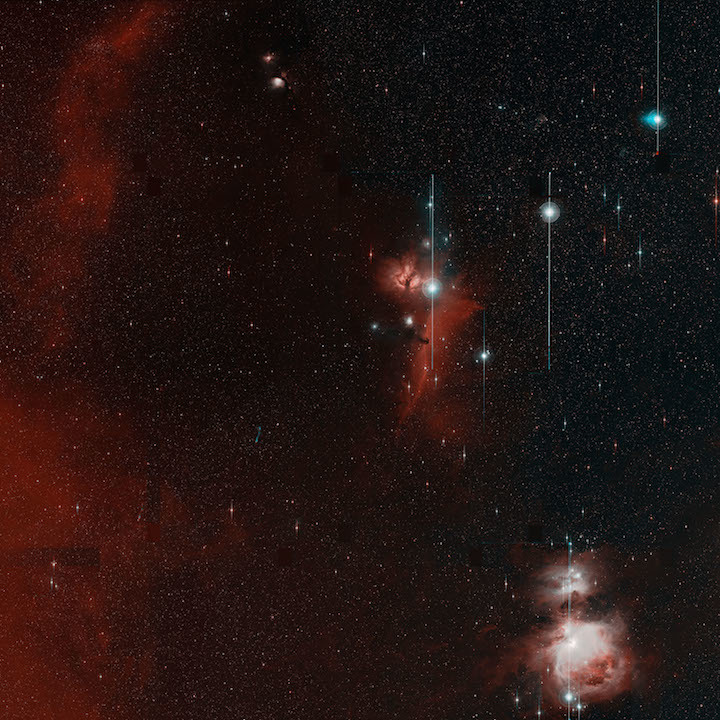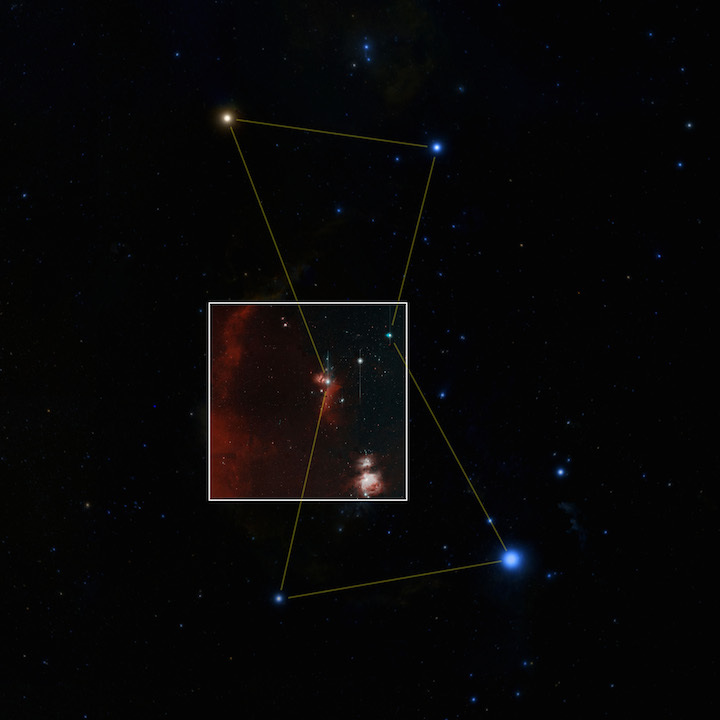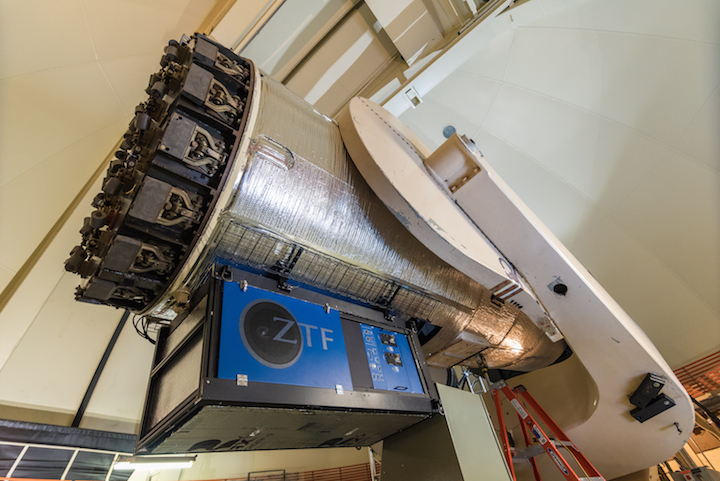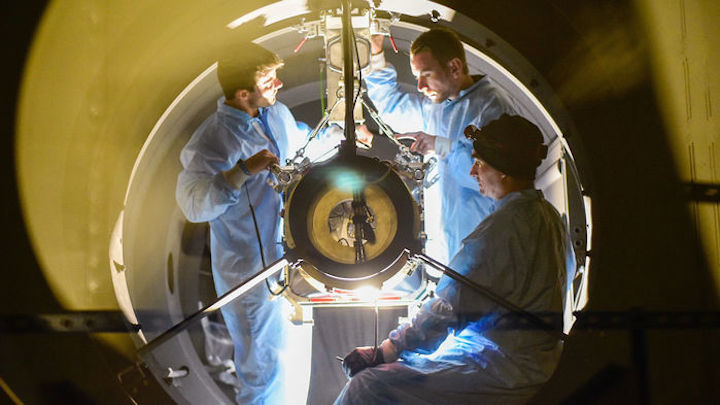15.11.2017

The ZTF took this “first light” image on Nov. 1, 2017, after being installed at the 48-inch Samuel Oschin Telescope at Palomar Observatory. The Horsehead nebula is near center and the Orion nebula is at lower right. The full-resolution version is more than 24,000 pixels by 24,000 pixels. Each ZTF image covers a sky area equal to 247 full moons.Caltech Optical Observatories
-
The first astronomers had a limited toolkit: their eyes. They could only observe those stars, planets and celestial events bright enough to pick up unassisted. But today’s astronomers use increasingly sensitive and sophisticated instruments to view and track a bevy of cosmic wonders, including objects and events that were too dim or distant for their sky-gazing forebears.
On Nov. 14, scientists with the California Institute of Technology, the University of Washington and eight additional partner institutions, announced that the Zwicky Transient Facility, the latest sensitive tool for astrophysical observations in the Northern Hemisphere, has seen “first light” and took its first detailed image of the night sky.
When fully operational in 2018, the ZTF will scan almost the entire northern sky every night. Based at the Palomar Observatory in southern California and operated by Caltech, the ZTF’s goal is to use these nightly images to identify “transient” objects that vary between observations — identifying events ranging from supernovae millions of light years away to near-Earth asteroids.
In 2016, the UW Department of Astronomy formally joined the ZTF team and will help develop new methods to identify the most “interesting” of the millions of changes in the sky — including new objects — that the ZTF will detect each night and alert scientists. That way, these high-priority transient objects can be followed up in detail by larger telescopes, including the UW’s share of the Apache Point Observatory 3.5-meter telescope.
“UW is a world leader in survey astronomy, and joining the ZTF will deepen our ability to perform cutting-edge science on the ZTF’s massive, real-time data stream,” said Eric Bellm, a UW assistant professor of astronomy and the ZTF’s survey scientist. “One of the strengths of the ZTF is its global collaboration, consisting of experts in the field of time-domain astronomy from institutions around the world.”
Identifying, cataloguing and classifying these celestial objects will impact studies of stars, our solar system and the evolution of our universe. The ZTF could also help detect electromagnetic counterparts to gravitational wave sources discovered by Advanced LIGO and Virgo, as other observatories did in August when these detectors picked up gravitational waves from the merger of two neutron stars.
But to unlock this promise, the ZTF requires massive data collection and real-time analysis — and UW astronomers have a history of meeting such “big data” challenges.

The ZTF “first light” image is shown here (inset) within the Orion constellation. The Orion nebula can be seen within the ZTF image.Caltech Optical Observatories
-
The roots of big data astronomy at the UW stretch back to the Sloan Digital Sky Survey, which used a telescope at the Apache Point Observatory in New Mexico to gather precise data on the “redshift” — or increasing wavelength — of galaxies as they move away from each other in the expanding universe. Once properly analyzed, the data helped astronomers create a more accurate 3-D “map” of the observable universe. The UW’s survey astronomy group is gathered within the Data Intensive Research in Astrophysics and Cosmology (DIRAC) Institute, which includes scientists in the Department of Astronomy as well as the eScience Institute and the Paul G. Allen School of Computer Science & Engineering.
“It was natural for the UW astronomy department to join the ZTF team, because we have assembled a dedicated team and expertise for ‘big data’ astronomy, and we have much to learn from ZTF’s partnerships and potential discoveries,” said UW associate professor of astronomy Mario Juric.

The ZTF installed on the 1.2-meter diameter Samuel Oschin Telescope. The large-format CCD camera at the heart of the ZTF is located inside the telescope tube, at the focus of the primary mirror.Caltech Optical Observatories
-
From Earth, the sky is essentially a giant sphere surrounding our planet. That whole sphere has an area of more than 40,000 square degrees. The ZTF utilizes a new high-resolution camera mounted on the Palomar Observatory’s existing Samuel Oschin 48-inch Schmidt Telescope. Together these instruments make up the duet that saw first light recently, and after months of fine-tuning they will be able to capture images of 3,750 square degrees each hour.
These images will be an order of magnitude more numerous than those produced by the ZTF’s predecessor survey at Palomar. But since these transient objects might fade or change position in the sky, analysis tools must run in near real time as images come in.
“We’ll be looking for anything subtle that changes over time,” said Bellm. “And given how much of the sky ZTF will image each night, that could be tens of thousands of objects of potential interest identified every few days.”
From a data analysis standpoint, these are no easy tasks. But, they’re precisely the sorts of tasks that UW astronomers have been working on in preparation for the Large Synoptic Survey Telescope, which is expected to see first light in the next decade. The LSST, located in northern Chile, is another big data project in astrophysics, and is expected to capture images of almost the entire night sky every few days.
“Data from the ZTF surveys will impact nearly all fields of astrophysics, as well as prepare us for the LSST down the line,” said Juric.
The ZTF is funded by the National Science Foundation and its partner institutions. The UW’s participation with the ZTF was made possible by funds provided by the College of Arts & Science, the DIRAC Institute and the Washington Research Foundation. The DIRAC Institute is funded in part by the Charles and Lisa Simonyi Fund for Arts and Sciences.
Quelle: University of Washington
+++
New California telescope aims to catch quickly moving celestial events

Zwicky Transient Facility team members install the instrument's new camera.
-
Astronomers in California have taken a telescope built before most of them were born and converted it into a new instrument dedicated to one of the newest and fastest-moving branches of astronomy: spotting objects in the sky that change from one day to the next.
The new Zwicky Transient Facility (ZTF), which today opened its eye to the sky, was created by retooling the 1.2-meter Samuel Oschin Telescope at the Palomar Observatory near San Diego, California, which, starting in 1948, took pictures of the night sky onto specially curved glass photographic plates. The ZTF, named in honor of Fritz Zwicky, the Bulgaria-born astronomer who worked for most of his career at the California Institute of Technology (Caltech) in Pasadena, has been fitted with a new camera made up of 16 charge-coupled device (CCD) detectors. That will enable it to snap single images covering an area more than 200 times the size of the full moon.
With such a wide field of view—the biggest of any telescope more than 0.5 meters wide—the ZTF can survey the whole northern sky visible from Palomar every night. By doing so, astronomers can spot anything that changes from the previous night’s images, enabling them to identify quickly changing celestial phenomena, including supernovae, variable and binary stars, the active cores of distant galaxies, potentially Earth-threatening asteroids, and the flash of merging neutron stars that could also emit gravitational waves.
Although the scientific haul is expected to be high, the ZTF is also a testbed for a larger upcoming instrument, the Large Synoptic Survey Telescope (LSST), which will begin observing from Chile in 2022. The LSST is expected to be so prolific that researchers will have to automate the process of sifting through observed events to find ones worth following up, and then getting a more detailed spectrum. To build such automated systems, ZTF researchers are involved in efforts to create the necessary data processing systems and robotic follow-up telescopes. “The headline goal is to get [an automated system] working and implemented in a way that astronomers can interact with it and use it,” says Adam Bolton of the National Science Foundation’s National Optical Astronomy Observatory (NOAO) in Tucson, Arizona.
Scaling up
In the past, the discovery of sudden events like supernovae was largely a matter of chance; a fortunate accident while astronomers were looking at something steadier. But in recent years interest in quickly changing phenomena has grown and a range of instruments has sprung up that use small telescopes to scan the sky on a nightly basis. The ZTF continues this trend but with a larger telescope to see fainter and more distant objects.
A key target will be a particular kind of supernova, known as type Ia, that is an important celestial yardstick because it is thought to always explode with the same luminosity. It was by studying type Ia supernovae that astronomers discovered in the 1990s that the expansion of the universe is accelerating, an effect ascribed to the mysterious dark energy. But what causes these explosions is not known for sure, so lingering doubts hang over their reliability as a measure. With the ZTF expecting to find thousands of type Ias per year, astronomers hope to put those doubts to rest and improve the accuracy of this yardstick.
The team behind the ZTF—which includes Caltech and partners at other U.S. universities and institutions in Israel, Sweden, Germany, and Taiwan—also expects to see each year more than a hundred superluminous supernovae, extra-bright explosions thought to be linked to gamma ray bursts, and a dozen or so tidal disruption events, flashes that occur when a star wanders too close to a supermassive black hole and is torn apart by its extreme gravity. Only a handful of such events have so far been confirmed, but astronomers hope if they can see more they will illuminate the notoriously camera-shy gravitational giants lurking at the centers of galaxies.
To achieve this, the team had to create a compact camera with a very wide field of view—47 square degrees. The camera’s 16 CCDs and electronics are enclosed in a cryostat to keep the detectors cold, and all of the gear must be small enough to fit in the center of the telescope at its focal point. The telescope’s drive motors were also changed so that the instrument can slew quickly from one patch of sky to another during observations. “It was amazing to take an old telescope and turn it into a supertelescope,” says Shrinivas Kulkarni, director of Caltech Optical Observatories, which has led the project.
New era of automation
Next decade, the LSST is expected to conduct regular surveys that are similar to the ZTF’s, but its 8.4-meter mirror will be able to see much more distant and fainter objects. The LSST is expected to detect as many as 10 million “events”—objects that change or appear—every night. “The ZTF will be an excellent forerunner for the fire hose of data expected from the LSST,” says Jonathan Grindlay of Harvard University, founding chair of the American Astronomical Society’s working group on time-domain astronomy.
That’s why automating data analyses will be critical. Researchers say stargazing will inevitably join forces with big data approaches, machine learning, and so-called event brokers, programs that can pick out the interesting events and then instruct robotic telescopes to take a closer look and obtain a spectrum so that an astronomer can peruse it later. Researchers at NOAO are working on such a broker system, as are others at the University of Washington in Seattle—who are partnered with the ZTF team—and elsewhere. “This is the best way to get ready” for the LSST, Kulkarni says. “We’ll go live, take data, and start doing things. ZTF will be the laboratory.”
The third part of the process—automated follow-up telescopes that can obtain spectra so astronomers can characterize events—is perhaps the least well prepared. The ZTF has teamed up with the Las Cumbres Observatory, which runs a worldwide network of 18 robotic telescopes, and the Liverpool Telescope, a robotic scope in the Canary Islands run by Liverpool John Moores University in the United Kingdom. “The challenge is to put all the pieces together so that scientific intelligence can be applied at the right time,” Bolton says.
If the whole system works, it may herald a new era when astronomers no longer have to spend long nights tending to observations but can simply turn up to work in the morning and have a whole menu of celestial delights waiting for them. Less romantic perhaps but, Kulkarni says: “The most efficient way to do astronomy is to get astronomers out of the dome.”
Quelle: Science
